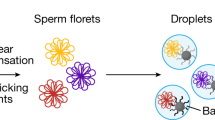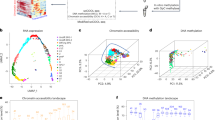Abstract
At the end of mammalian spermatogenesis, chromatin in differentiating germ cells is extensively remodeled, with the majority of nucleosomes being removed and ultimately exchanged by highly basic proteins named protamines. Residual nucleosomes are, to various degrees, retained at regulatory sequences in human and mouse sperm. Moreover, certain histone variants and modifications remain present in regulatory sequences of subsets of genes in spermatozoa, providing opportunities for paternal inheritance of chromatin states and epigenetic control of gene expression in the subsequent generation. Here we describe in detail a method that enables the generation of soluble chromatin samples from mouse and human spermatozoa within 1 d. These samples are amendable to chromatin immunoprecipitation and high-throughput sequencing of nucleosome-associated genomic DNA, which require several additional days. We also provide computational scripts that allow straightforward analysis of large genome-wide data sets by biologists with limited computational experience. This protocol will facilitate studies of mechanisms of chromatin remodeling and epigenetic reprogramming during spermatogenesis and of paternal epigenetic inheritance. Similarly, it will help in the study of the causes of human male infertility.
This is a preview of subscription content, access via your institution
Access options
Subscribe to this journal
Receive 12 print issues and online access
$259.00 per year
only $21.58 per issue
Buy this article
- Purchase on Springer Link
- Instant access to full article PDF
Prices may be subject to local taxes which are calculated during checkout





Similar content being viewed by others
Accession codes
Change history
26 February 2014
In the version of this article initially published, the amount of N-ethylmaleimide to be dissolved was incorrect; it should be 25 mg rather than 0.25 mg. It was also not specified that the N-ethylmaleimide solution should be 1 M. In addition, the catalog number from Sigma-Aldrich for sodium acetate was incorrectly given as S2889; it should be S8625. Also, it should have been stated that the sodium acetate required is ·3H2O. The errors have been corrected in the HTML and PDF versions of the article.
References
Govin, J., Caron, C., Lestrat, C., Rousseaux, S. & Khochbin, S. The role of histones in chromatin remodelling during mammalian spermiogenesis. Eur. J. Biochem. 271, 3459–3469 (2004).
Balhorn, R., Gledhill, B.L. & Wyrobek, A.J. Mouse sperm chromatin proteins: quantitative isolation and partial characterization. Biochemistry 16, 4074–4080 (1977).
Gatewood, J.M., Cook, G.R., Balhorn, R., Bradbury, E.M. & Schmid, C.W. Sequence-specific packaging of DNA in human sperm chromatin. Science 236, 962–964 (1987).
Gardiner-Garden, M., Ballesteros, M., Gordon, M. & Tam, P.P. Histone- and protamine-DNA association: conservation of different patterns within the β-globin domain in human sperm. Mol. Cell. Biol. 18, 3350–3356 (1998).
Wykes, S.M. & Krawetz, S.A. The structural organization of sperm chromatin. J. Biol. Chem. 278, 29471–29477 (2003).
Pittoggi, C. et al. A fraction of mouse sperm chromatin is organized in nucleosomal hypersensitive domains enriched in retroposon DNA. J. Cell Sci. 112 (Part 20): 3537–3548 (1999).
Arpanahi, A. et al. Endonuclease-sensitive regions of human spermatozoal chromatin are highly enriched in promoter and CTCF binding sequences. Genome Res. 19, 1338–1349 (2009).
Hammoud, S.S. et al. Distinctive chromatin in human sperm packages genes for embryo development. Nature 460, 473–478 (2009).
Brykczynska, U. et al. Repressive and active histone methylation mark distinct promoters in human and mouse spermatozoa. Nat. Struct. Mol. Biol. 17, 679–687 (2010).
Erkek, S. et al. Molecular determinants of nucleosome retention at CpG-rich sequences in mouse spermatozoa. Nat. Struct. Mol. Biol. 20, 868–875 (2013).
Vavouri, T. & Lehner, B. Chromatin organization in sperm may be the major functional consequence of base composition variation in the human genome. PLoS Genet. 7, e1002036 (2011).
Gill, M.E., Erkek, S. & Peters, A.H. Parental epigenetic control of embryogenesis: a balance between inheritance and reprogramming? Curr. Opin. Cell Biol. 24, 387–396 (2012).
Pembrey, M.E. et al. Sex-specific, male-line transgenerational responses in humans. Eur. J. Hum. Genet. 14, 159–166 (2006).
Kaati, G., Bygren, L.O., Pembrey, M. & Sjostrom, M. Transgenerational response to nutrition, early life circumstances and longevity. Eur. J. Hum. Genet. 15, 784–790 (2007).
Nadeau, J.H. Transgenerational genetic effects on phenotypic variation and disease risk. Hum. Mol. Genet. 18, R202–R210 (2009).
Ng, S.F. et al. Chronic high-fat diet in fathers programs beta-cell dysfunction in female rat offspring. Nature 467, 963–966 (2010).
Anway, M.D., Cupp, A.S., Uzumcu, M. & Skinner, M.K. Epigenetic transgenerational actions of endocrine disruptors and male fertility. Science 308, 1466–1469 (2005).
Chong, S. et al. Modifiers of epigenetic reprogramming show paternal effects in the mouse. Nat. Genet. 39, 614–622 (2007).
Carone, B.R. et al. Paternally induced transgenerational environmental reprogramming of metabolic gene expression in mammals. Cell 143, 1084–1096 (2010).
Zeybel, M. et al. Multigenerational epigenetic adaptation of the hepatic wound-healing response. Nat. Med. 18, 1369–1377 (2012).
van der Heijden, G.W. et al. Chromosome-wide nucleosome replacement and H3.3 incorporation during mammalian meiotic sex chromosome inactivation. Nat. Genet. 39, 251–258 (2007).
Gaucher, J. et al. From meiosis to postmeiotic events: the secrets of histone disappearance. FEBS J. 277, 599–604 (2010).
Matzuk, M.M. et al. Small-molecule inhibition of BRDT for male contraception. Cell 150, 673–684 (2012).
Goldberg, A.D. et al. Distinct factors control histone variant H3.3 localization at specific genomic regions. Cell 140, 678–691 (2010).
Umlauf, D., Goto, Y. & Feil, R. Site-specific analysis of histone methylation and acetylation. Methods Mol. Biol. 287, 99–120 (2004).
Langmead, B., Trapnell, C., Pop, M. & Salzberg, S.L. Ultrafast and memory-efficient alignment of short DNA sequences to the human genome. Genome Biol. 10, R25 (2009).
Mohn, F. et al. Lineage-specific polycomb targets and de novo DNA methylation define restriction and potential of neuronal progenitors. Mol Cell 30, 755–766 (2008).
Robinson, M.D., McCarthy, D.J. & Smyth, G.K. edgeR: a Bioconductor package for differential expression analysis of digital gene expression data. Bioinformatics 26, 139–140 (2010).
Hublitz, P., Albert, M. & Peters, A.H. Mechanisms of transcriptional repression by histone lysine methylation. Int. J. Dev. Biol. 53, 335–354 (2009).
World Health Organization. WHO Laboratory Manual for the Examination and Processing of Human Semen 5th edn. (2010).
Acknowledgements
We gratefully acknowledge J. Hofsteenge for critical advice during the development of this protocol. We thank T. Roloff (FMI functional genomics group), I. Nissen (Laboratory for Quantitative Genomics, Department of Biosystems Science and Engineering (D-BSSE), Basel) and the FMI animal facility for excellent assistance. S.E. is supported as a recipient of a Boehringer Ingelheim Fond fellowship. Research in the Stadler and Peters laboratories is supported by the Novartis Research Foundation and the Swiss Initiative in Systems Biology (Cell Plasticity - Systems Biology of Cell Differentation). In addition, the Peters laboratory receives funding from the Swiss National Science Foundation (31003A_125386 and National Research Programme NRP63—Stem Cells and Regenerative Medicine), the Japanese Swiss Science and Technology Cooperation Program, the FP7 Marie Curie Initial Training Network “Nucleosome4D” and the EMBO Young Investigator Program.
Author information
Authors and Affiliations
Contributions
M.H., S.E., M.B.S. and A.H.F.M.P. conceived of and designed the experiments. M.H., with help of S.D.-B., developed the sperm chromatin isolation protocol, whereas S.E. and M.B.S developed the computational scripts and pipeline. L.R. contributed the purification protocol for human sperm. M.B.S. also provided bioinformatics training and support. S.E., M.H., M.B.S. and A.H.F.M.P. analyzed the data. S.E., M.B.S. and A.H.F.M.P. prepared the manuscript.
Corresponding authors
Ethics declarations
Competing interests
The authors declare no competing financial interests.
Supplementary information
Supplementary Table 1
GEO identifiers (XLSX 12 kb)
Supplementary Data 1
Analysis of Next-generation-sequencing data with R (PDF 965 kb)
Supplementary Data 2
R code for analysis of next generation sequencing data (TXT 5 kb)
Supplementary Data 3
R_function_definitions_used_by_the_R_code_in_Supplementary_Files_1_and_2 (TXT 15 kb)
Rights and permissions
About this article
Cite this article
Hisano, M., Erkek, S., Dessus-Babus, S. et al. Genome-wide chromatin analysis in mature mouse and human spermatozoa. Nat Protoc 8, 2449–2470 (2013). https://doi.org/10.1038/nprot.2013.145
Published:
Issue Date:
DOI: https://doi.org/10.1038/nprot.2013.145
This article is cited by
-
Emerging evidence that the mammalian sperm epigenome serves as a template for embryo development
Nature Communications (2023)
-
Sperm chromatin accessibility’s involvement in the intergenerational effects of stress hormone receptor activation
Translational Psychiatry (2023)
-
Sperm chromatin structure and reproductive fitness are altered by substitution of a single amino acid in mouse protamine 1
Nature Structural & Molecular Biology (2023)
-
Chromatin alterations during the epididymal maturation of mouse sperm refine the paternally inherited epigenome
Epigenetics & Chromatin (2022)
-
Alcohol induced increases in sperm Histone H3 lysine 4 trimethylation correlate with increased placental CTCF occupancy and altered developmental programming
Scientific Reports (2022)
Comments
By submitting a comment you agree to abide by our Terms and Community Guidelines. If you find something abusive or that does not comply with our terms or guidelines please flag it as inappropriate.



